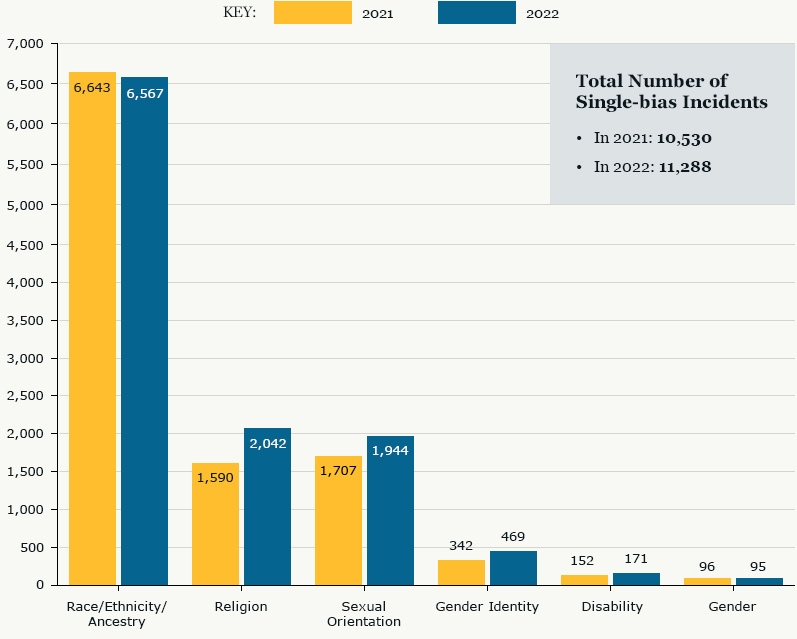Facts and Statistics
FBI Releases 2022 Hate Crime Statistics
The FBI's Uniform Crime Reporting (UCR) Program serves as the national repository for crime data voluntarily collected and submitted by law enforcement. Its primary objective is to generate reliable information for use in law enforcement administration, operation, and management. The 2022 hate crimes data, submitted by 14,631 law enforcement agencies, provide information about the offenses, victims, offenders, and locations of hate crimes. Of these agencies who submitted incident reports, there were 11,634 hate crime incidents involving 13,337 offenses.
Victims of Hate Crime Incidents
| Bias Motivation Categories for Victims of Single-bias Incidents in 2022 |
Single-bias Incident Bias Motivations by Category in 2022
| Offenses by Crime Category | Known Offenders | Location Type |
|---|---|---|
Among the 13,377 hate crime offenses reported:
| Of the 10,299 known offenders:
Other races accounted for the remaining known offenders. Of the 7,671 known offenders for whom ethnicity was reported:
Of the 8,487 known offenders for whom ages were known:
| Law enforcement agencies may specify the location of an offense within a hate crime incident as 1 of 46 location designations.
The remaining 22.0% of hate crime incidents took place at other or multiple locations. |
Federal Bureau of Investigation Crime Data Explorer
The FBI's Crime Data Explorer (CDE) aims to provide transparency, create easier access, and expand awareness of criminal, and noncriminal, law enforcement data sharing; improve accountability for law enforcement; and provide a foundation to help shape public policy with the result of a safer nation. Use the CDE to discover available data through visualizations, download data in .csv format, and other large data files. The CDE also features hate crime statistics (see the "read more" link below).
Visit the 2021 and 2020 Hate Crime Statistics pages to view FBI hate crimes data for 2021 and 2020.
Description of images on this page
Bias Motivation Categories for Victims of Single-bias Incidents in 2022: This is a pie chart showing the percentage of bias motivation categories for victims of single-bias incidents in 2022. They are as follows:
| Race/Ethnicity/Ancestry | 59.1% |
| Religion | 17.3% |
| Sexual Orientation | 17.2% |
| Gender Identity | 4.0% |
| Disability | 1.5% |
| Gender | 0.9% |
Single-bias Incident Bias Motivations by Category: This is a bar chart showing the 2022 and 2021 data for bias motivation categories for single bias incidents. They are as follows:
| Bias Motivation Categories | 2022 | 2021 |
|---|---|---|
| Race/Ethnicity/Ancestry | 6,567 | 6,643 |
| Religion | 2,042 | 1,590 |
| Sexual Orientation | 1,944 | 1,707 |
| Gender Identity | 469 | 342 |
| Disability | 171 | 152 |
| Gender | 95 | 96 |
| Total | 11,288 | 10,530 |




